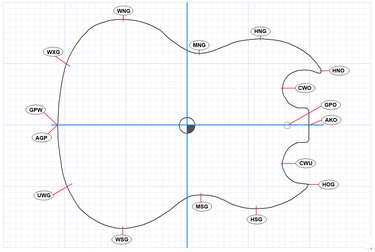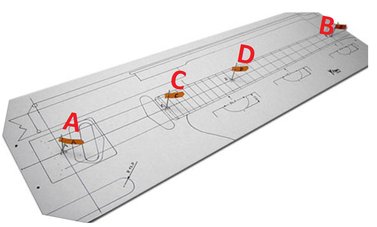Checkpoints

In order to be able to describe the body shape of an electric guitar precisely, a lot of data or specifications (“specs”) are required.
The question is, what is the minimum amount of data necessary to draw a silhouette of one type of guitar?
As boundary stones mark a plot of land in geodesy, 12 to 16 orientation points are sufficient for the rough outline of the body.
For a description or representation of a complete guitar body with the pickups, buttons, neck pocket, hardware, etc., this is of course not enough. Further coordinates can be defined for these details.
In order to be able to check the transferred contours, in addition to the width and length of the body, one would also have to have the distance of the vertical scale line from the body end on the center line. And you look in vain for those in the usual specifications.
With coordinates and a systematic selection of checkpoints, a database with specifications can be easily created and maintained.
Basically, all parameters of a guitar can be addressed as numerical values using X, Y or Z coordinates.
Influence of CP's
The body zero point Z P is of course not a direct component of the outline (contours, silhouette), but similar to the center of a circle, the z e r o p o i n t is automatically "present" in every coordinate.
A - the BODY ZERO POINT, lies exactly at the intersection of the center line and the scale line,
B - the NECK and HEAD ZERO POINT marks the position of the NUT, more precisely the front edge of the saddle (or the center of the crown of the zero fret),
The belly area:
These are the checkpoints of the widest area of the body:
AGP-GPW-WXG-UWG und WNG-WSG
With symmetrical bodies the points AGP and GPW ( strap button) are in the same position. As a rule, they have the largest minus value –X and Y = 0.
With asymmetrical and some offset shapes, such as Flying V, Explorer and for example some B.C. Rich models, either the UWG or the WXG point has the largest minus value –X.
A larger area, or more mass of the abdominal area, reduces the tendency of the guitar to become bulky. The highest possible X value for the GPO also counteracts head lushness. This is mainly the case with the electric basses, where the AGP has a significantly smaller value –X and the GPO value X extends up to the octave range of the powerful bass scale.
The checkpoints WNG and WSG, which define the body width, differ noticeably for electric guitars and electric basses. For guitars their X-coordinates are in the minus range, for basses they have positive X-values.
The reason for this lies in the significantly longer scale length of the bass instruments (mostly 34 ") compared to guitar scale lengths (e.g. 24.75" ... 25 "... 25.5"). The core of an electric bass is inevitably "pushed" deeper into the body


Comments (0)
No comments found!